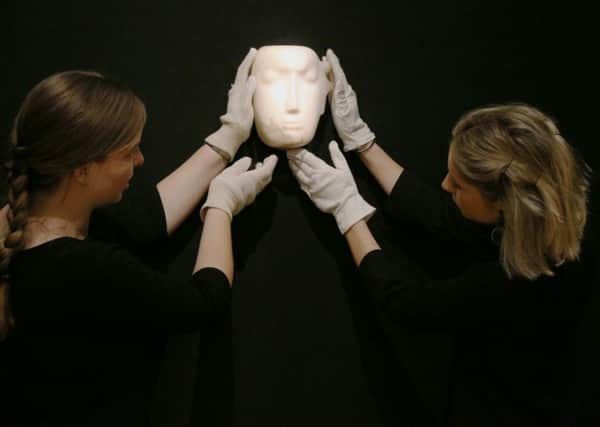Less is Moore: The tiny sculpture with £1m price tag


The sale tomorrow of a rare alabaster example of one of Henry Moore’s Masks left no-one in any doubt as to the Yorkshire sculptor’s place among the pantheon of collectable artists.
Bonhams unveiled the piece yesterday. One of only 12 known small carvings produced by Moore between 1924 and 1930 and the only one in alabaster, it was acquired in the early 1930s by the Salmon family who ran the Lyons Corner House tea room empire, and has been in private hands ever since.
Advertisement
Hide AdAdvertisement
Hide AdThe auctioneers placed a guide price on it of between £1m and £1.5m, but at the Yorkshire Sculpture Park, near Moore’s old home and where some of his larger works are displayed, its director of programme Clare Lilley said: “They’ll get a lot more than that.”
Ms Lilley had been in the London auction room at Christie’s two years ago when Moore’s ground-breaking modernist sculpture of a reclining figure, produced for the 1951 Festival of Britain, sold for a record £24.7m.
“I can’t tell you how exciting it was that night. The atmosphere was electric,” she said. “It’s extraordinary how you get caught up in it because I wasn’t bidding – but my heart was pounding.”
But the guide price for the reclining figure was up to £10m less than the amount it realised – which, said Ms Lilley, pointed to the value now placed on Moore.
Advertisement
Hide AdAdvertisement
Hide Ad“Along with Barbara Hepworth, he is far and away the most important British sculptor of the 20th century,” she said. “I suppose what this tells us is that blue chip art isn’t impacted by economic decline. It’s better than gold bars.
“Not only does it hold its value but it accrues like nothing else. That’s why the very wealthy buy cars and art – it’s a way of banking.”
The art critic Jonathan Jones, a former jury member for the Turner prize, has accused Moore and the Wakefield-born Hepworth of not deserving a place among the international art world’s premier league.
But Ms Lilley said: “The truth is that they are both right up there. As a result of their influence, there are many places in the world that would give their eye teeth to be called Yorkshire.”
Advertisement
Hide AdAdvertisement
Hide AdIt was in 2012 that Moore overtook Damien Hirst, another artist with a pervading Yorkshire influence having studied in Leeds, as Britain’s most expensive sculptor. Among international 20th century sculptors, Moore is in the top five, above Picasso and behind only Giacometti, Modigliani, Matisse and Brancusi.
He died in 1986 and was wealthy in his lifetime, yet the scale of his success had not always been apparent.
“Like a lot of artists he went through a doldrum period, but the last 15 years has seen his popularity in market value, museum exhibitions and public response explode,” Ms Lilley said.
“What really did it was that Christie’s sale in 2016.”
Matthew Bradbury, the director of modern British and Irish Art at Bonhams, said the Mask to be sold by the auction house tomorrow was “arguably the most visually appealing and beautiful” from the series.
Advertisement
Hide AdAdvertisement
Hide AdHe said: “It shows the deep impact of the ninth century Toltec-Maya sculpture, Chac Mool from Yucatan in Mexico, which Moore first saw at the Trocadero Museum in Paris.
“He was also influenced by the great Romanian-born modernist sculptor, Constantin Brancusi, with his tenet of ‘truth to materials’, and by Amadeo Modigliani, whom Brancusi had encouraged to take up sculpture.”
Only four of Moore’s Masks remain in private collections, with others at the Henry Moore Foundation, Leeds City Art Gallery and the Tate.
Born in Castleford and educated in Leeds, Moore was at the forefront of funding British sculpture and remained so after his death, Ms Lilley said.
Advertisement
Hide AdAdvertisement
Hide Ad“He created a foundation that has been an incredible legacy for this country. He’s really been the cornerstone for funding sculpture and without the Henry Moore Foundation we simply would not be in the place that we are, with Britain at the forefront of contemporary sculpture.”
She added: “There really isn’t a climate of snobbery about Yorkshire sculptors. You’ve got Moore, Hepworth and Hirst – that’s quite an incredible threesome.”